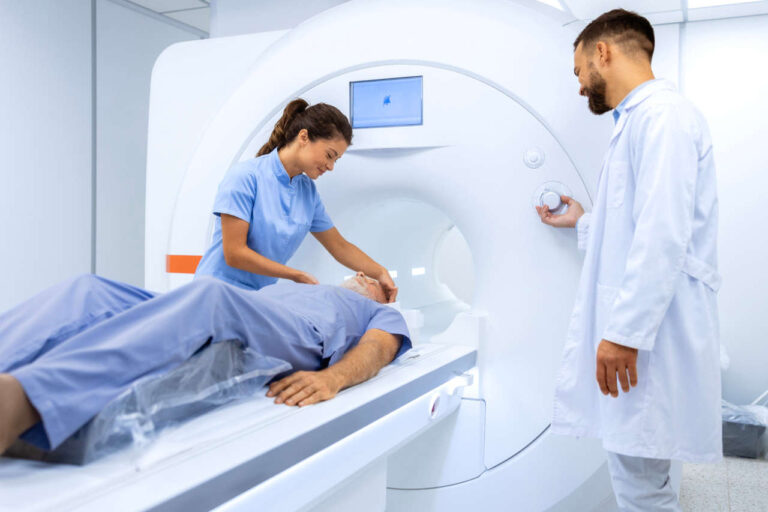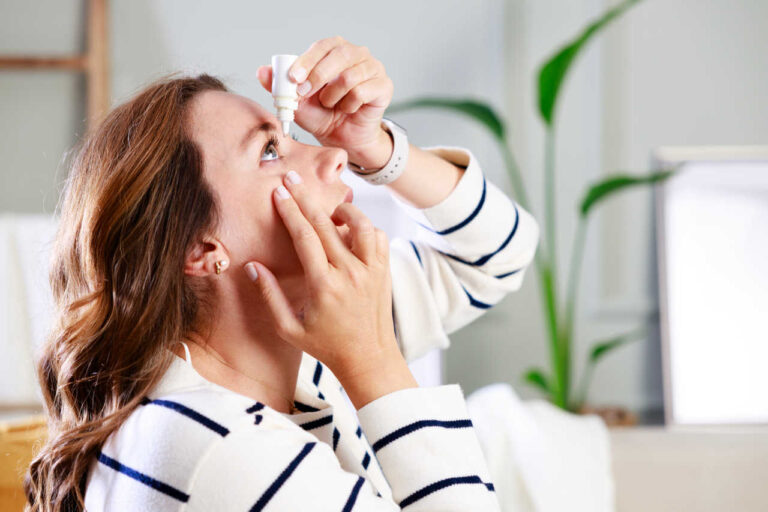
Ankylosing spondylitis (pronounced as ank-ee-lo-zing spon-dee-li-tus) or AS is a form of chronic inflammatory arthritis that predominantly affects your spine — a bony structure that provides your body shape and posture. The term “ankylosing” means stiffness; “spondyl” pertains to the spine or vertebra, and “itis” refers to inflammation. In essence, ankylosing spondylitis (AS) leads to inflammation in the spinal joints, which results in progressive stiffness and chronic pain, especially in the lower back. This inflammatory condition is also known as Bechterew’s disease.
Speak to a Specialist About Copay Assistance
The symptoms of AS typically first show up in late adolescence or early adulthood. Men are three times more likely to get AS. In the United States, approximately 1.7 million adults have AS, according to the Centers for Disease Control and Prevention’s NHANES study.
In this article, we will provide a brief overview of AS, including its symptoms, causes, risk factors, diagnosis, and treatment strategies for people with this condition or who are at a higher risk of developing it.
Before we delve into the basics of AS, it is important to understand this condition and how it affects your spine over time.
Understanding Ankylosing Spondylitis
Your spine is a long column of bones that extend from your neck to your lower back. It is made up of several bones and soft tissues (i.e., collagen) that are joined together like bricks stacked on top of one another. Normally, your spine allows your body to move in every direction. For instance, the spinal joints attached to your hip bone, called sacroiliac joints, allow you to walk, twist and bend.
However, in the case of people with AS, the chronic inflammation of the joints in the spine makes the spine stiff. For example, daily activities like bending, walking, standing, and sitting become challenging for people with AS due to persistent lower back or joint pain.
Moreover, in more advanced cases, inflammation can cause new bone formation (ankylosis) in which a section of the spine fuses together. This fusion leads to spinal deformities, and with time, the spine gradually loses its flexibility and mobility, which results in a hunched back and limited movement.
Though it’s rare, AS also affects other large joints such as hips, shoulders, and, less often, ankles and knees. As the illness worsens, it may impact the joints connecting the ribs and spine, limiting chest movement and making it difficult to breathe deeply.
What Are the Common Symptoms of Ankylosing Spondylitis?

The onset of AS symptoms can differ. For example, some individuals may experience mild episodes of pain, while others may experience chronic, severe pain.
The most common early signs of AS are stiffness and frequent pain in the lower back and hip area (buttocks), which usually develops gradually over more than 3 months. Over time, the pain can spread up to the entire spine, into your neck, and may affect other parts of the body.
Other symptoms include:
- Stomach pain and diarrhea
- Inflammatory bowel syndrome or bowel inflammation (seen in 50% of cases)
- Psoriasis (reported in 10% of cases)
- Enthesitis
- Dactylitis (inflammation in the entire finger or toe)
- Anemia
- Back pain and stiffness
- Fatigue
- Vision change and eye pain due to uveitis (seen in 25 – 30% of cases)
- Weight loss and loss of appetite
- Breathing difficulty if affected spinal joints connect to your ribs
Some people may feel more pain in the middle of the night or after extended sitting because the pain can worsen during rest or inactivity. Exercise and movement can typically help reduce discomfort.
What Causes Ankylosing Spondylitis?
Though the exact cause of AS is unknown, researchers believe that both genetics and environmental factors play a role in developing this disease. Research shows that genetics increases your risk of developing AS.
The human leukocyte antigen-B (HLA-B27) gene is a marker of AS, and 90% – 95% of people who develop AS have the HLA-B27 mutation gene. Your risk of AS increases if someone in your family or first-degree relatives has this condition.
However, in some rare cases, this gene is present but AS is never developed. This tells researchers that this is not a purely genetic disease. Environmental factors like a viral or bacterial infection may also need to be present to trigger the onset of AS disease in susceptible people.
What Are the Risk Factors?
Besides a genetic factor (human leukocyte antigen-B [HLA-B27] gene), there are other factors that may increase your risk of developing AS. These factors include:
- Age: People younger than 40 are more likely to develop AS. For instance, around 80% of people experience the symptoms of AS before 30, and 5% are diagnosed with AS by the age of 40.
- Gender: AS is three times more common in males than females.
- Race: Non-Hispanic white people are at higher risk of developing AS than other ethnic groups.
- Underlying diseases: People having other autoimmune conditions like Crohn’s disease, ulcerative colitis, and psoriasis are more likely to develop AS.
How Ankylosing Spondylitis Is Diagnosed
Diagnosis of AS may be difficult since the presentation of back pain may be due to various health issues. Doctors may conduct multiple tests, as a single test cannot be used to diagnose accurately. In susceptible patients, rheumatologists do physical examinations and follow testing procedures. For example, a rheumatologist will ask:
- About your symptoms, their severity, and how long you’ve had them
- About your medical condition, like if you have an autoimmune disorder or any other disease
- About your family history and if anyone in your family has AS
Based on your physical evaluation, if a rheumatologist suspects AS, then they will order genetic blood tests (for HLA-B27 gene detection) and take an imaging test, like an X-ray or MRI, to examine the appearance of your spine and pelvis, mainly the condition of the sacroiliac joint, which is the main joint that gets damaged in AS.
Get Financial Assistance
How Is Ankylosing Spondylitis Treated?
Though there is no cure for AS yet, rheumatologists typically suggest particular treatment approaches that help in managing this condition and reducing the pain severity.
Common treatments for AS include:
Medication
Certain medications like NSAIDs and biologic DMARDs are typically prescribed to ease pain and inflammation. This also helps to slow the progression of AS symptoms.
Exercise
Since the symptoms of AS progressively improve with regular physical activity, exercise is typically recommended. Exercises like swimming, yoga, stretching, deep breathing, and posture practices can help maintain flexibility and range of motion.
Surgery
Although rare, it is possible that in severe cases, a healthcare provider will recommend joint replacement surgery if a deformity is present in the knees or hip joints. People with poor posture due to fused bones may undergo an osteotomy. During this procedure, a surgeon will cut and realign the bones in the spine.
When To Visit a Doctor
If you have been experiencing severe back pain for the last 2 months or if your pain gets worse after you stop taking medications like NSAIDs, then you should consult your doctor immediately for an evaluation.
The classical presentation of AS is that pain worsens at night or early in the morning (when you rest) and improves with exercise.
Is There a Cure for Ankylosing Spondylitis?
Currently, there is no cure for ankylosing spondylitis. However, early diagnosis and effective treatment strategies such as medications, physical therapy, and good posture exercises can help reduce the symptoms and manage this condition.
Conclusion
Ankylosing spondylitis (AS) is a rare form of chronic inflammatory arthritis that affects the spine as well as other joints throughout the body. The clinical presentation of AS is frequent pain and stiffness in the lower back and buttocks, which can worsen and affect other big joints if left untreated. This condition can be easily managed with early diagnosis and effective treatment strategies.
REFERENCES:
- Branch, N. S. C. a. O. (2023, December 15). Ankylosing spondylitis. National Institute of Arthritis and Musculoskeletal and Skin Diseases. https://www.niams.nih.gov/health-topics/ankylosing-spondylitis#:~:text=Ankylosing%20spondylitis%20is%20a%20type,help%20us%20move%20and%20bend.
- Spondylitis Association of America. (2020, April 3). Treatment of Ankylosing Spondylitis – Spondylitis Association of America – Ankylosing Spondylitis. Spondylitis Association of America – Ankylosing Spondylitis. https://spondylitis.org/about-spondylitis/overview-of-spondyloarthritis/ankylosing-spondylitis/treatment-ankylosing-spondylitis/
- Wenker, K. J. (2023, June 20). Ankylosing spondylitis. StatPearls – NCBI Bookshelf. https://www.ncbi.nlm.nih.gov/books/NBK470173/
- Tam, L., J, G., & Yu, D. T. Y. (2010). Pathogenesis of ankylosing spondylitis. Nature Reviews Rheumatology, 6(7), 399–405. https://doi.org/10.1038/nrrheum.2010.79
- Ebrahimiadib, N., Berijani, S., Ghahari, M., & Pahlaviani, F. G. (2021). Ankylosing Spondylitis. Journal of Ophthalmic & Vision Research, 16(3), 462-469. https://doi.org/10.18502/jovr.v16i3.9440
- Mauro, D., Thomas, R., Guggino, G., Lories, R., Brown, M. A., & Ciccia, F. (2021). Ankylosing spondylitis: An autoimmune or autoinflammatory disease? Nature Reviews Rheumatology, 17(7), 387-404. https://doi.org/10.1038/s41584-021-00625-y
- Hwang, M., Ridley, L. K., & Reveille, J. D. (n.d.). Ankylosing spondylitis risk factors: a systematic literature review. Clinical Rheumatology, 40(8), 3079–3093. https://doi.org/10.1007/s10067-021-05679-7













